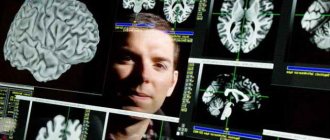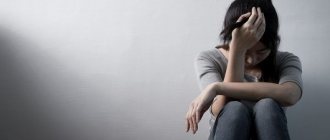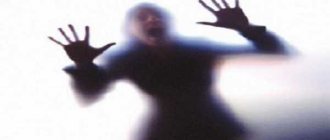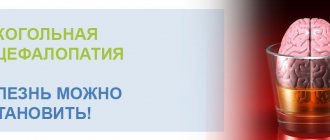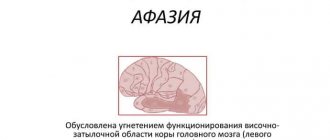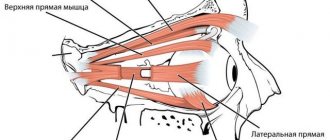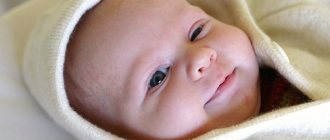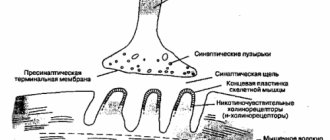Patients with depressive syndrome (depression) suffer from a decrease in the ability to receive joy and pleasure from life, they lose interest in what is happening, energy and activity, and cannot concentrate on anything. Even small efforts make them tired, their appetite decreases, and their sleep is disturbed. Patients are not confident in themselves, they have low self-esteem, even to the point of thinking about their own uselessness and futility.
Depressive syndrome is manifested by three main symptoms:
- Hypotymia , ranging from slight depression to the deepest melancholy with an understanding of the futility and worthlessness of one’s existence.
- Slowing down of thinking , its impoverishment and chaining to unpleasant experiences. Patients answer questions in monosyllables, taking a long pause.
- Retardation in movements and speech up to depressive stupor (complete immobility). Sometimes such lethargy is replaced by an explosion of melancholy, during which the patient may suddenly jump up, start banging his head against the wall, screaming, howling, and inflicting various injuries on himself. In this case, it should be held until the attack weakens and lethargy returns.
Classification of depression and its types
There are two main types of depression:
- exogenous (the disorder is caused by environmental influences, for example, the death of a loved one or loss of a job);
- endogenous (the disorder is caused by an internal conflict, the cause of which in most cases remains unclear).
Chronic
The main difference from the clinical one is the length and severity. Symptoms are milder, but appear over a period of 2 years or more. A person can lead his usual lifestyle - communicate with family, go to work, however, his mood is always noticeably depressed, his former hobbies are no longer of interest, and the company of new people is frightening.
Problems with physical condition help to more accurately determine the diagnosis - insomnia, loss of appetite, lack of performance, regular headaches, decreased libido, changes in behavior.
Important! With chronic depression, the menstrual cycle may be disrupted.
Chronic depression makes a person more withdrawn and detached from the rest of the world. Suicidal thoughts and intentions appear.
Bipolar
Bipolar (manic) is the most severe type of depression. The disorder is transmitted through heredity or arises against the background of other mental disorders.
The main feature of the bipolar type is a sudden, causeless change in mood. In the first period of time, the patient is irritable, depressed, refusing communication and his own hobbies. Slow speech and lack of physical and mental activity may be present.
The second period is radically different from the first - the person is in a state of euphoria, talks a lot, laughs, makes plans, cannot sit still, always working on something. The period of bright activity is usually less long-term.
Important! At the height of the disease, hallucinations, attacks of aggression or delusions may occur.
This type of mental disorder requires regular observation in a hospital and drug treatment. The patient's further condition is also unstable, since relapses may occur or other mental illnesses may appear.
Masked
Masked depression is difficult to diagnose, since the symptoms are hidden by the appearance of somatic pathologies.
Bad mood, apathy and physical malaise can be attributed to vegetative-vascular dystonia, arterial hypertension, osteochondrosis and other similar diseases.
In the psychoanalytic concept, one of the symptoms of masked depression is hyperactive activity.
The patient does not want to accept the fact of depression, completely focusing on his own health, forgetting about family and work responsibilities, and self-care.
Important! Masked depression is difficult to treat due to the patient’s reluctance to take action. It is necessary to combine a visit to a psychotherapist and drug treatment that will improve the patient’s condition.
Neurotic
Neurotic depression is a mixture of a classic type of disease and neurosis. Most often occurs in people with a weak nervous system or a certain type of character.
The main cause of neurotic depression is a conflict or a stalemate from which the patient does not see a way out. Typical symptoms are mixed with signs of neurosis - headaches, digestive system problems, muscle and joint pain.
In most cases, the patient himself realizes that he needs help.
Atypical
With atypical depression, in addition to the main symptoms, there is an increase in appetite, constant drowsiness, a desire to cry, pain throughout the body, increased anxiety and panic attacks.
Important! For atypical depression, tranquilizers and mood stabilizers are prescribed to help eliminate panic attacks.
Postpartum
This type of depression can occur both after a normal, successfully completed birth, and after an interrupted pregnancy, miscarriage, frozen pregnancy, or stillbirth. The cause of postpartum depression can be a sharp hormonal surge.
Important! For mothers who have given birth for the first time, depression occurs after 2-4 months.
Postpartum depression is characterized by: increased emotionality, internal emptiness, anxiety, guilt, indifference, and sometimes even aggression towards the child.
Causes of this disease
Until now, scientists have not been able to find out the reasons for the development of depressive disorders. There are 2 types of factors that can trigger the onset of the disease:
- biological - a decrease in hormones responsible for a person’s mood and well-being can be caused by genetic predisposition, infectious or endocrine diseases, or overwork;
- psychological - any mental trauma, difficult life situation or constant stress can also cause depression.
It is believed that chronic depressive disorder most often occurs due to constant nervous overload, personality traits and overwork. Unlike other, more severe and rapidly developing forms, such as endogenous or psychotic depression, genetic predisposition and psychological trauma are less important in this pathology.
Long-term and indolent depression usually occurs in people experiencing constant nervous overload and stress, without the opportunity for rest and relaxation. This type of disorder can occur in people who spend a lot of time working hard and nervous work or are forced to care for seriously ill relatives, in the absence of normal rest and proper sleep.
Depression often occurs in people who are overly responsible, conscientious, and serious, if they lead a lifestyle imposed on them by others, voluntarily giving up self-realization, favorite activities or relationships.
Residents of megacities suffer more from chronic depressive disorder; the state of the nervous system is negatively affected by too fast a pace of life, high levels of stress when communicating with others, lack of physical activity, chronic lack of sleep and high air pollution. All these factors weaken a person’s health and resistance to irritants of the nervous system and can cause the development of depressive states of varying severity.
Depressive syndrome: causes
Various and numerous variants of the origin of depressive syndrome have been described. This pathological symptom complex very often serves as an indicator of the presence of severe mental disorders in a person, such as:
- bipolar affective disorder, also called manic depressive disorder;
- recurrent depressive disorder;
- postpartum depression;
- seasonal affective disorder.
Depressive syndrome can also be one of the symptoms of schizoaffective disorder , with depressive symptoms occupying a dominant position in comparison with the phenomena characteristic of schizophrenia.
Depressive syndrome can be a consequence or concomitant of a variety of chronic or acute somatic and mental illnesses. Symptoms characteristic of depression can be observed in mental disorders caused by infectious diseases, such as:
- flu;
- malaria;
- rabies;
- hepatitis A;
- typhoid fever.
Depressive syndrome may indicate a stroke, malignant neoplasms, or epilepsy. Often, depressive syndrome is a consequence of endocrine disorders. Symptoms of depression can occur with vitamin deficiencies.
Causes of depressive syndrome also include taking certain pharmacological medications . Thus, symptoms of depression can develop during drug treatment with antipsychotics, hormonal drugs, antibiotics, oral contraceptives, and antihypertensive drugs.
Fatigue and depression
The term “chronic fatigue” was established in the world classification of diseases in 1987. The essence of the disease is constant weakness and lethargy, accompanied by the inability to get enough sleep and rest.
Many people often confuse fatigue and depression, but these two phenomena are fundamentally different, although one can provoke the other (mutual dependence).
Among the main differences are the following:
- Depression is an affective disorder, that is, a person’s emotions undergo active changes. The mechanism of chronic fatigue involves more bodily processes.
- Unlike depression, chronic fatigue does not have physiological causes in its clinical picture (meaning such as blocking of neurotransmitters in depression). According to doctors, chronic fatigue is the result of complex (spiritual, intellectual and physical) prolonged overload.
- New nature: if depressive disorder has been known to mankind for several centuries, then pathological fatigue syndrome is a new phenomenon. Sociologists associate this with the rhythm of life of modern man, which has accelerated to incredible limits, and increased responsibility in all spheres of life.
How to distinguish depression from neurosis? Find out the answer right now.
Chronic fatigue and depression - where is the line? Psychology:
Depressive syndrome: symptoms
Schizoaffective disorder can be successfully treated if it is recognized at the very beginning. This can be done if you know the 3 main signs of a developing disease:
- decline in intellectual abilities, inhibited thinking;
- permanent bad mood;
- decline in activity.
If you discover the listed symptoms, it is better not to postpone a visit to a psychoanalyst.
There are other signs of depressive syndrome. They are classified into physical and emotional.
Symptoms of an emotional nature are the following:
- sadness:
- sadness;
- despondency;
- desire to cry;
- lack of satisfaction with one's own life;
- fear of not being realized;
- feeling of worthlessness;
- unreasonable attacks of aggression;
- irritability;
- feeling of loneliness and uselessness.
Physically, the disease manifests itself as follows:
- loss or increase in appetite;
- insomnia or vice versa, drowsiness;
- frequent fatigue;
- exacerbation of chronic diseases, as well as the development of new ones;
- decreased motor activity;
- decreased libido;
- a change in weight up or down.
It is worth saying that for each individual person the symptoms will be different: for some, a full range of symptoms will be present, and for others, the disease will be indicated by several symptoms. In addition, the situation will be aggravated by a person’s social environment: his personal relationships in the family, with friends and colleagues, situations at work, conflict situations. In other words, negative emotions and experiences can undermine a person’s mental health.
Depressive syndrome: symptoms
The presence of depressive syndrome is evidenced by regularly occurring persistent symptoms - noticeable and uncomfortable changes in the emotional sphere. The main symptom of depressive syndrome is an unreasonable decrease in mood, perceived by a person as burdensome melancholy, despondency, and apathy.
Along with a decrease in mood, the individual’s mental functions decrease . It is difficult for him to concentrate on the task at hand, he becomes distracted and inattentive. A person notices the appearance of memory problems; it is difficult for him to remember new information and reproduce previously learned information.
A person suffering from depressive syndrome notices a decrease in work productivity . It is difficult for a patient with depressive syndrome to quickly cope with professional responsibilities. A person caught in the net of depression forces himself to perform his usual activities through volitional efforts. He becomes slow and sluggish.
Common symptoms of depressive syndrome are changes in eating behavior. A patient with this disorder may notice a deterioration in appetite or, conversely, may overeat heavily. The intimate sphere of life also undergoes changes: a person’s attraction to the opposite sex decreases or completely disappears.
The leading symptoms of depressive syndrome also include changes in self-esteem and negative perception of one’s own personality. A sick person develops obsessive ideas of his own guilt, worthlessness, and sinfulness. In severe depressive syndrome, the appearance of symptoms of suicidal behavior comes to the fore. A person begins to think in negative terms about the meaning of life, thinks about committing suicide as the only way out for him.
Symptoms of depressive syndrome are also a decrease in a person’s interests and needs. The sick person stops performing previously exciting tasks, reduces her social circle, and stops attending entertainment events. Often a person with depressive syndrome withdraws into his “cocoon”, becoming a voluntary hermit. A person can be alone for hours or days, while she makes a minimum number of movements, “freezing” in a static position.
Causeless melancholy and depressing despondency can outwardly manifest itself as the patient’s tearfulness. A person with depressive syndrome becomes suspicious, impressionable and capricious. He can react to any remark addressed to him with a stormy stream of tears.
It should be noted that with severe depressive syndrome, the patient’s physical well-being also worsens . Chronic illnesses may worsen in a person. His immune system becomes defenseless against the harmful effects of viruses and microbes. He begins to get colds often.
Also, with depression, the quality of a person’s sleep deteriorates. Common symptoms of depressive syndrome are persistent insomnia, nightmares at night, frequent awakenings at night, shallow sleep, and getting up too early in the morning.
Diseases characterized by depressive syndrome
Often, depressive syndrome is observed within the framework of bipolar affective disorder (F 31 31.) or recurrent depression (F 33 33.). In addition, this syndrome is characteristic of schizophrenia and schizoaffective disorder. The severity of individual symptoms included in the structure of the depressive syndrome varies, depending on the specific disease and the characteristics of its course in each patient.
Depressive syndrome can also be of somatogenic origin, that is, arise as a result of somatic diseases. Somatogenic depression can develop with infectious, toxic, organic and other psychoses, with stroke, epilepsy, tumors and brain injuries, Parkinson's disease, various endocrine diseases (in particular, thyroid dysfunction), vitamin deficiencies, etc.
Depressive syndrome can also be caused by side effects of certain medications: for example, antipsychotics, hormonal drugs, antibiotics, analgesics, antihypertensive drugs.
Causes and symptoms of heart rhythm disturbances
Have you been trying to cure HYPERTENSION for many years?
Head of the Institute of Treatment: “You will be amazed at how easy it is to cure hypertension by taking it every day...
Read more "
The heart is an important human organ that performs the functions of a pump. In a healthy body, the heart rate remains constant and even. Various deviations cause heart rhythm disturbances. This disease is called arrhythmia. The normal contraction frequency (HR) is considered to be between 60 and 80 beats per minute. An increase or decrease in this indicator indicates diseases of the cardiovascular system.
The contraction of the heart is carried out by the conduction system of the body. This includes the sinus node (the site of the electrical impulse), the atrioventricular node (which transmits the signal to the His bundle), and the Purkinje fibers (necessary for contraction of the ventricular muscles). Normally, the heartbeat is sinus. Those. each impulsive signal that provokes contraction of the heart muscle leaves the sinus node and passes down the conductive passages. Correct heart contraction occurs with equal frequency.
Classification of arrhythmias
Heart rhythm disturbances are divided into two types based on the frequency of heart contractions.
- Tachycardia (with a heart rate of more than 80 beats per minute): characterized by the body’s reaction to external conditions (stress, overexertion, emotional impact, increased body temperature). An increase in heart rate at rest indicates significant deviations in the functioning of the heart. In such a situation, timely assistance from a doctor is necessary.
- Bradycardia (with a heart rate less than 60 beats per minute): develops in a calm state in completely healthy people.
Bradycardia and tachycardia occur without the development of heart pathologies.
A separate classification of heart rhythm disorders includes three types of arrhythmias.
- Deviations when an impulse occurs. If the impulse is generated in the sinus node, then this type includes bradycardia and tachycardia. And when a signal occurs from other parts of the conducting mechanism, an ectopic excitation node is formed (i.e., a focus that is located in the wrong place). It is usually located in the atrioventricular node, in the atria or ventricles. In this case, the impulse is transmitted either along descending paths or along ascending paths. This group of cardiac arrhythmias includes certain conditions: slow (escaping) and fast (ectopic) rhythms, extrasystole and paroxysmal tachycardia. Due to ectopic foci of excitation, fibrillation (flicker) and flutter of the atria and ventricles develop.
- Conduction disorders in the heart. This condition is called blockade. Blocks appear in different parts of the conduction mechanism, preventing the passage of the impulse. The classification involves several types of blockades: intraatrial, atrioventricular, sinoatrial, and bundle branch block. This type also includes ventricular asystole (cardiac arrest) and Wolff-Parkinson-White syndrome (SVC syndrome).
- Combined types. This classification implies a division into atrioventricular dissociation, parasystole and ectopic rhombuses with exit block. In this case, the additional (ectopic) focus of excitation and the sinus node work separately (due to blockade). As a result, a double formation of rhythmicity occurs; the ventricles and atria work in different rhythms.
In the presence of cardiac pathologies, most patients suffer from ventricular and atrial extrasystole. In this case, premature contraction is added to the normal rhythm. Heart rhythm disturbances occur with vegetative-vascular dystonia, sore throat, severe stress, smoking abuse, and after myocarditis.
Another common type of heart rhythm disorder is atrial fibrillation (classified by the disturbance in the occurrence of the impulse). In this case, there is no phase of atrial contraction. In this case, the muscle fibers lose synchrony in their work, and the atria twitch chaotically.
Reasons for the development of arrhythmia
Heart rhythm disturbances are not always considered a pathology. In certain situations, bradycardia, single extrasystoles of the ventricles and atria, and sinus arrhythmia occur during sleep. The causes of a slow heart rate can be caused by a vagal effect on the heart (slowing heart rate under the influence of the vagus nerve). Tachycardia often occurs against the background of emotional influence, stress and severe physical exertion. Active heart contractions appear when there are disturbances in the functioning of the autonomic nervous system (with an increase in the concentration of adrenaline in the blood - the stress hormone). Bad habits and abuse of stimulating drinks (coffee, energy drinks) also lead to the appearance of tachycardia and extrasystole.
The reasons for the deterioration of heart function and vascular condition are associated with changes in the electrolyte composition of the blood. When the balance of certain microelements in the body (potassium, sodium, magnesium) changes under the influence of inflammatory processes, fever, hypothermia and overheating, poisoning, isolated episodes of heart rhythm disturbances occur. When the cause of the patient’s condition is eliminated, the heart rate returns to normal. No special treatment is required.
Risk factors for arrhythmia:
- age (people over 45 years old);
- hereditary predisposition;
- abuse of bad habits;
- excess weight.
Severe forms of arrhythmia occur against the background of concomitant diseases. In this case, the causes of heart contraction disorders are associated with the presence of certain pathologies:
- diseases of the heart and blood vessels (myocardial infarction, ischemia, arterial hypertension, heart defects, endocarditis, myocarditis, heart failure);
- neurological problems and diseases (brain injuries, tumor formations, vegetative-vascular dystonia, neuroses, problems in the blood circulation of the brain);
- endocrine problems (premenstrual syndrome in women, menopause, diabetes mellitus, hypothyroidism, hyperthyroidism, adrenal tumor);
- diseases of the gastrointestinal tract (chronic cholecystitis, pancreatitis, gastric ulcer, hiatus hernia).
In some situations, the causes of the disease cannot be determined. In this case, an idiopathic heart contraction disorder is diagnosed.
Symptoms of the disease
The clinical picture of various types of arrhythmias manifests itself differently, depending on the characteristics of the patient’s body. In rare cases, symptoms of heart rate disorders are not observed at all, and the disease can be diagnosed only during a routine examination by a cardiologist. But most often, heart rhythm disturbances are accompanied by obvious signs.
Main symptoms of arrhythmia:
Hypertension will go away, and the pressure will be 120 over 80 if you include it in the diet...
Hypertension will disappear forever! Here's the secret...
- increased heart rate (with tachycardia) and slower heart rate (with bradycardia);
- feeling of heartbeat;
- noticeable interruptions in the functioning of the heart (“freezing” of the heartbeat during extrasystole);
- weakness, dizziness, fainting;
- shortness of breath and pain in the chest area;
- feelings of anxiety, panic and other disorders of a neurotic nature.
Features of arrhythmia in children
Unlike adults, in whom arrhythmia is diagnosed against the background of concomitant diseases, cardiac arrhythmias in children are equally associated with congenital developmental pathologies and with conditions during the normal functioning of the cardiovascular system.
According to statistics, about 27% of children suffer from various types of heart rate disorders. Children at puberty are most at risk, when functional changes occur in almost all body systems.
Often, arrhythmia in children occurs due to excessive psychological stress. By identifying the causes and eliminating them, the symptoms and signs of heart rhythm disturbances in children are almost completely eliminated.
The main feature of arrhythmia in children is the latent course of the disease. Often, problems with cardiac contractility are detected at an older age during examination. Children do not complain of standard symptoms of arrhythmia, and the clinical picture of the disease usually manifests itself in psychomotor behavior (increased nervousness, tearfulness, irritability, sleep disturbances, short-term loss of consciousness).
Pronounced cardiac dysfunction in children significantly affects their well-being and requires medical intervention. With timely diagnosis of the disease, the prognosis for life in children with arrhythmia is quite good.
Special treatment for heart rhythm disturbances in children not associated with organic pathologies is not required. As a rule, this condition regresses on its own over time. Treatment of other forms of arrhythmia begins with the correction of children’s daily routine (work, study and rest), nutrition, as well as the use of elements of conservative therapy. In especially severe forms, surgical intervention is required.
Conservative treatment of arrhythmia in children involves taking the following medications:
- beta blockers;
- sedatives;
- cardiac glycosides (in the presence of concomitant heart failure).
Treatment with conventional antiarrhythmic drugs in children is carried out with caution, with a clear selection of dosage and drug regimen. Timely treatment helps to completely block attacks of heart rhythm disturbances, and also reduces the risk of complications in adulthood.
Diagnosis and treatment of the disease
If a patient, when examined by a doctor, complains of typical symptoms of arrhythmia, then diagnosing the disease will not be difficult. The specific type of heart rhythm disturbance is determined only by the results of an electrocardiogram (ECG).
Extrasystole is characterized by changes in ventricular complexes, tachycardia - by short intervals between contractions, atrial fibrillation - by irregular rhythm and frequency of contractions.
Additional methods for diagnosing arrhythmia include:
- monitoring of blood pressure and heart rate throughout the day (Holter diagnostics);
- measurements under load (not cycling, walking on stairs, on a treadmill);
- ECG through the esophagus (specifies the location of the arrhythmia);
- electrophysiological study through the esophagus (by stimulating heart contractions to identify a specific type of arrhythmia).
In some cases, cardiac ultrasound and MRI are performed (to identify tumor formations).
Depending on the type of arrhythmia and the patient’s condition, treatment is prescribed. Short-term heart rhythm disorders are treated on an outpatient basis. In especially severe cases, treatment is carried out in a hospital setting. Methods such as defibrillation, cardiac pacing, and catheter ablation are used.
Among the medications for arrhythmia are:
- blood thinners;
- remedies for high cholesterol;
- antihypertensive drugs for high blood pressure;
- diuretics (for chronic heart failure);
- antiarrhythmic drugs (to normalize heart rate).
Heart block and bradycardia require different treatment. Drugs are prescribed to “accelerate” the heart rate and increase heart rate.
After completing treatment, the patient is sent to a cardiologist. Regular examinations, ECG, and monitoring of heart rate indicators are necessary.
Possible complications and long-term prognosis
Against the background of the development of various types of arrhythmia, serious complications may occur:
- collapse: a sharp drop in blood pressure below 100 mm. rt. Art., weakness, fainting;
- ischemic stroke (with increased formation of blood clots in the cardiac cavity): sudden speech impairment, problems with balance, partial or complete paralysis of the limbs;
- arrhythmogenic shock (with a sharp decrease in blood flow in the brain or organs): loss of consciousness, cyanosis of the skin, low blood pressure, rare pulse, serious condition of the patient;
- acute myocardial infarction (with a lack of oxygen in the tissues of the heart, necrosis of myocardial cells occurs): sharp severe pain in the heart area;
- pulmonary embolism (a condition that occurs when an artery is blocked by a blood clot): sudden shortness of breath, a feeling of suffocation, bluish skin;
- fibrillation, cardiac arrest and clinical death (complete cessation of myocardial contractions): in the absence of emergency assistance, biological death is possible.
In the absence of pathological changes in the heart and serious complications, the prognosis for life in people with arrhythmia is favorable. In other cases, the life and health of the patient is determined by the severity and form of the disease, the treatment undertaken and lifestyle.
Any cardiovascular disease that causes problems with the heart can cause serious complications. When the first symptoms of heart rhythm disturbances or pain appear, immediate consultation with a doctor is required. Timely diagnosis and proper treatment of the disease will normalize heart rate and reduce the risk of developing pathological processes.
Types of depressive disorder
In psychiatry, depressive syndrome has several types. Each of them is characterized by certain features.
Manic-depressive syndrome
This type of disorder is characterized by a change in 2 phases - manic and depressive. In the intervals between them, normalization of the condition is possible. The manic phase is characterized by the following manifestations:
- psychomotor agitation;
- bursts of energy;
- active gestures;
- fast thought processes;
- good mood.
In this state, the client talks and laughs a lot. He is prone to overestimating his capabilities, and therefore often takes on overwhelming work. Such people often develop confidence in their own genius. They are able to pass themselves off as representatives of creative professions - actors, writers or artists.
The depressive phase of this condition has the opposite symptoms. These include the following:
- depressed state;
- lethargy;
- stiffness of movements;
- yearning;
- deterioration of intellectual functions.
The duration of the depression phase exceeds that of mania. The frequency of such conditions can vary - from a couple of days to several months. People with this diagnosis tend to be aware of their condition and view it critically. However, they are not able to cope with it.
In simple situations, pathology is treated on an outpatient basis. In difficult conditions, a person is admitted to a hospital and prescribed powerful antidepressants.
Astheno-depressive syndrome
This term refers to a mental disorder that is accompanied by the following symptoms:
- weakness;
- constant headaches;
- retardation of movements;
- high fatigue;
- anxiety;
- high sensitivity;
- slowdown of intellectual processes;
- speech problems.
Violation has different causes. They can be internal or external. The first category includes stress and emotional disturbances. External factors include various pathologies. In depressive syndrome, these are infections, heart and vascular diseases, malignant diseases, and complex surgical interventions.
In adolescents, the manifestations of this type of depressive syndrome often acquire a pronounced negative connotation. In this case, the following symptoms occur:
- systematic tantrums;
- coarseness;
- increased irritability, anger;
- causeless protests.
The prolonged course of the disease often leads to the appearance of a guilt complex. He is joined by a gloomy assessment of his condition and the outside world.
The asthenic-depressive type of pathology negatively affects the physical condition. As a result of the disease, the functioning of the digestive organs is disrupted, blood pressure increases, and sleep and appetite deteriorate. Women are at risk of having problems with their periods. Sexual desire often disappears.
After the elimination of somatic manifestations of the disease or proper rest, the person’s condition improves. Treatment methods are determined by the severity of the pathology. Sometimes short psychotherapy is enough. In difficult situations, a long course of treatment and antidepressants will be required.
Anxiety-depressive syndrome
Characteristic symptoms of this form of depressive syndrome include excessive anxiety and panic attacks. This condition most often occurs in teenagers. This is due to high emotionality and vulnerability. An inferiority complex is also often the cause.
A depressed patient is characterized by the appearance of fears of various origins. Gradually they transform into phobias. Teenagers with this diagnosis fear punishment for their actions, including imperfect ones. They consider themselves not smart enough, talented or beautiful enough.
With the development of pathology, a person cannot correctly assess the surrounding reality and different situations in it. Against this background, persecution mania often appears. It seems to people that everyone is deceiving them, trying to lure them into a trap.
Suspicion, suspiciousness, and increased sensitivity are constant companions of pathology. A person spends all his energy fighting dangers that do not exist in reality.
What causes dysthymia and how it manifests itself?
As with other mental health disorders, experts cannot give a clear answer about the causes of the disease. Among the prerequisites for the occurrence of dysthymia may be hereditary and social factors, the presence of stressful situations, but the main reason, nevertheless, is considered to be the biochemical processes occurring in the human central nervous system.
Serotonin is responsible for the emotional state; a lack of this neurotransmitter leads to the development of chronic depression. Some medications can cause a deficiency of the “happiness hormone”. The chances of developing dysthymia also increase if you have a chronic illness. Alcoholism or drug addiction can lead to the disease.
The symptoms of dysthymia are, in general, similar to the manifestations of other types of depressive disorders, only the severity of the main symptoms differs:
the feeling of sadness and emptiness is constant; a person cannot fall asleep for a long time in the evening, after which a difficult awakening occurs. Other sleep disorders are also possible
This may be constant drowsiness or insomnia; awareness of one’s own helplessness and uselessness in this world, the thought that a person is unable to influence the current situation, a feeling of hopelessness; lack of interest in activities that previously brought pleasant sensations; increased fatigue, decreased overall tone; problems with concentration and attention. Mental stress is extremely tiring, it becomes difficult to make choices and decisions; changes in eating behavior. Appetite may increase greatly or disappear completely; periodically have thoughts of suicide or death
Appetite may increase greatly or disappear completely; Periodically there are thoughts about suicide or death.
Chronic depression can also have somatic manifestations. The patient may experience headaches, digestive system problems, and joint pain.
Some of the listed symptoms may be character traits, but if such manifestations are more than 80%, then you need to consult a doctor.
Dysthymia does not have a paralyzing effect, the person does not feel the need for complete isolation, he continues to work or study. Those around him simply consider him a slow and reserved person. But if you notice signs of a disease such as dysthymia, treatment should begin immediately.
Chronic depression affects a person's self-esteem, reduces their quality of life and prevents them from enjoying favorite activities, and, in some cases, can lead to suicide.
This disorder can develop differently in different people. The depressive episode may be major, and such incidents may recur with some frequency or not occur at all.
In some cases, dysthymia turns into acute depression, which then returns to a chronic course. Experts call this condition double depression. To prevent the development of complications, treatment of the disorder should begin as soon as the first symptoms are noticed.
Provoking factors
Depressive syndrome is characteristic of schizoaffective disorder.
In addition, the reasons for its appearance may be the following:
- brain damage;
- various types of psychoses;
- suffered a stroke;
- diseases of the endocrine system;
- tumor formations;
- reduction in the amount of vitamins in the blood;
- use of certain types of medications: hormonal, sedatives, antibiotics and others.
The advanced stage of the syndrome, resulting from ignoring provoking factors, can be fatal.
Symptoms and causes of the disease
There is no consensus on the causes of depression. There are 4 main theories: prolonged exposure to stress, genetic predisposition, the presence of neuropsychiatric disorders, increased sensitivity.
The main symptom is melancholy. Depending on the severity of the pathology, it can vary from a slight feeling of depression to a complete suppression of the desire to live. Reactions and movements are slow. In some cases, a condition similar to shock numbness is observed. Sometimes lethargy can be replaced by attacks of activity, during which the patient becomes hysterical: he screams, tries to injure himself, hurt himself. Brain function slows down. The person answers questions after a long pause.
There is a decrease in appetite, patients complain of sleep disturbances and apathy. The disease negatively affects a person’s physical health.
What will ultrasound of the heart show: standards and deviations in the study protocol
Why is echocardiography performed?
EchoCG is used to identify changes in the structure of cardiac muscle tissue, dystrophic processes, malformations and diseases of this organ.
A similar study is carried out on pregnant women if there is a suspicion of pathology of fetal development, signs of developmental delay, the presence of epilepsy, diabetes mellitus, or endocrine disorders in the woman.
Indications for echocardiography may include symptoms of heart defects, suspected myocardial infarction, aortic aneurysm, inflammatory diseases, neoplasms of any etiology.
An ultrasound of the heart must be performed if the following symptoms are observed:
- chest pain;
- weakness during physical activity and regardless of it;
- cardiopalmus:
- interruptions in heart rhythm;
- swelling of the arms and legs;
- complications after influenza, ARVI, sore throat, rheumatism;
- arterial hypertension.
The examination can be done at the direction of a cardiologist or at your own request. There are no contraindications to its implementation. There is no special preparation for a cardiac ultrasound; it is enough to calm down and try to maintain a balanced state.
During the study, the specialist evaluates the following parameters:
- the state of the myocardium in the phase of systole and diastole (contraction and relaxation);
- the size of the heart chambers, their structure and wall thickness;
- the condition of the pericardium and the presence of exudate in the cardiac sac;
- functioning and structure of arterial and venous valves;
- the presence of blood clots, neoplasms;
- the presence of consequences of infectious diseases, inflammation, heart murmurs.
The results are most often processed using a computer program.
More details about this research methodology are described in this video:
Normal values in adults and newborns
It is impossible to determine uniform standards for the normal state of the heart muscle for men and women, for adults and children of different ages, for young and elderly patients. The figures below are average values and there may be slight differences in each case.
| Indicators | In adults | In newborns |
| Left ventricular wall thickness in systole | 10 – 16 mm | 4 – 5 mm |
| The same - in diastole | 8 - 11 mm | 3 – 4 mm |
| Right ventricular wall thickness | 3 – 5 mm | |
| Thickness of the interventricular septum in systole | 10 – 15 mm | 4 – 8 mm |
| The same - in diastole | 6 – 11 mm | 3 – 5 mm |
| Aortic diameter | 18 – 35 mm | |
| Left ventricular ejection fraction | More than 50% | 66 – 76% |
| Heart rate | 70 — 75 | 120 — 140 |
| Myocardial mass | 90 – 140 g – for women 130 – 180 g – for men |
The aortic valve in adults should open 1.5 centimeters or more, the opening area of the mitral valve in adults is 4 sq.cm. The volume of exudate (liquid) in the heart sac should not exceed 30 sq. ml.
Deviations from the norm and principles for interpreting results
As a result of echocardiography, the following pathologies of the development and functioning of the heart muscle and accompanying diseases can be detected:
- heart failure;
- slowing, accelerating or interrupting heart rhythm (tachycardia, bradycardia);
- pre-infarction condition, post-infarction;
- arterial hypertension;
- vegetative-vascular dystonia;
- inflammatory diseases: cardiac myocarditis, endocarditis, exudative or constrictive pericarditis;
- cardiomyopathy;
- signs of angina pectoris;
- heart defects.
The examination protocol is filled out by a specialist performing cardiac ultrasound. The parameters of the functioning of the heart muscle in this document are indicated in two values - the norm and the indicators of the subject. The protocol may contain abbreviations that are incomprehensible to the patient:
- LVMM – left ventricular mass;
- LVMI – mass index;
- EDD – end diastolic size;
- DO – long axis;
- KO – short axis;
- LA – left atrium;
- RA – right atrium;
- EF – ejection fraction;
- MK – mitral valve;
- AK – aortic valve;
- DM – myocardial movement;
- DR – diastolic size;
- SV – stroke volume (the amount of blood that is ejected by the left ventricle in one contraction;
- ТМВПд – thickness of the myocardium of the interventricular septum in the diastole phase;
- TMMVPs – the same, in the systole phase.
Depressive syndrome - what to do?
This disorder is a dangerous disease that requires immediate initiation of therapy. Treatment methods involve the use of medications and other procedures.
Doctors usually prescribe the following:
- use of sedatives, psychotropic drugs, tranquilizers;
- various forms of psychotherapy, help from psychologists and psychiatrists;
- giving up bad habits, maintaining a healthy lifestyle;
- providing a person with comfortable conditions - sometimes it is necessary to change jobs or social circles;
- normalization of work and rest schedules;
- compliance with recommendations for proper nutrition;
- use of physiotherapy - you can use music treatment, healing sleep, light therapy and other activities.
To cope with fear and panic attacks, you can master the technique of meditation. To do this, you should watch the video:
Depressive syndrome is a dangerous disease that is accompanied by unpleasant symptoms and can negatively affect physical health. To cope with this condition, it is necessary to consult a psychotherapist in a timely manner and strictly follow his recommendations.
How to process the results?
Processing the results
Each item must be scored from 0 to 3. The total score can range from 0 to 63, the lower it is, the better the person’s condition.
The results are interpreted as follows:
- from 0 to 9 – no depression;
- from 10 to 15 – mild depressive state;
- from 16 to 19 – moderate;
- from 20 to 29 – average depression;
- from 30 to 63 – severe form of depression.
If you notice symptoms of depression, you must consult a doctor immediately. As for treatment, it can be done both with the help of psychotherapeutic methods and with the use of medications. Read tablets for sinusitis and sinusitis on our website.
See a psychologist for support and treatment for depression
Treatment of depressive syndrome
To treat mild forms, vitamin supplements and a visit to a psychotherapist are prescribed.
Cognitive behavioral therapy is used, which is also used to treat OCD (obsessive-compulsive disorder). This method of influence helps the patient to realize the presence of dysfunction, reduces the severity of negative manifestations, helps to form new patterns of behavior, and destroy habits that support a depressive state.
Interpersonal psychotherapy connects the patient's condition with social situations. Emotions and behavioral reactions are considered in relation to relationships with other people.
Family psychotherapy is used. This method of influence helps to normalize relationships within the family and replace forms of communication from destructive to constructive.
In severe cases, medications are used. Antidepressants are used, less often - tranquilizers. For lethargy and apathy, medications with a stimulating effect are prescribed. Anxious depression can be treated with sedative antidepressants. The drug should be selected by a doctor, since the wrong drug can increase anxiety or suicidal thoughts.
In severe cases, treatment is carried out in a hospital setting, since constant monitoring of the patient by doctors is required.
Antidepressants
Treatment of asthenic-depressive syndrome cannot be accomplished without the use of medications. To alleviate symptoms of psychoemotional disorders, antidepressants are prescribed.
During their appointment, the patient gets the opportunity to adequately assess his situation, learn about the factors that caused depression and take appropriate measures. To achieve recovery, it is necessary to maintain the correct daily routine, adhere to an appropriate diet, and be physically active.
If you have ADS, it is advisable to do physical exercise.
It is important to understand that medications used to provide temporary relief are not a panacea for mental disorders. Antidepressants belong to the category of addictive drugs.
Therefore, the goal of doctors is to develop a strategy to prevent the occurrence of new attacks. The treatment regimen for each patient is developed individually.
To bring a person out of a state of depression, Incazan, Fluoxetine, Mipramine, Azafen are used.
To enhance the sedative effect, plant-based sedatives (Sedasen, Novo-passit) and antipsychotics are prescribed.
Diet
Organizing nutritional therapy is an effective way to get rid of many mental disorders. Astheno-depressive syndrome is no exception, the treatment of which is impossible without diet correction.
Diet therapy is an effective method, and if used in a timely manner, antidepressants and antipsychotics may not be needed.
This diet involves the maximum exclusion from the diet of fatty foods, sweets, especially rich foods.
The emphasis in nutrition should be on porridge, dairy products, and lean meat. It is recommended to include dried fruits, all types of nuts, peas, beans and eggs in the daily menu. For sweets, it is allowed to consume dark chocolate in small quantities, as well as bananas, dates and honey.
Sport
Increasing physical activity during depression syndrome improves the psycho-emotional state of the patient: it reduces the manifestation of depression and is one of the effective methods against blues.
It is not recommended to start playing sports suddenly; a gradual start is needed.
For depression syndrome, any type of amateur sports is suitable: swimming, cycling, running, brisk walking, dancing, gymnastics. Movement is a natural antidepressant, so even exercise in the morning with such a diagnosis will give a positive result.
In parallel, you can use auto-training, aroma and herbal medicine, which will help restore the physical and mental strength of the body.
Causes, first aid and treatment of vegetative-vascular crisis
Vegetative-vascular crisis is an acute form of the syndrome, characterized by a psycho-vegetative disorder that occurs as a result of impaired functions of the entire reticular complex. The disease affects the organs of the cardiovascular system.
- Types of vegetative-vascular crises
- Symptoms by type
- Dystonic syndrome
- First aid in a crisis situation
- Treatment
The crisis has many manifestations and is accompanied by the following disorders:
- vegetative;
- neurotic;
- metabolic;
- endocrine.
The very word “crisis” indicates that an extreme, non-standard, critical situation occurred in the body, to which the body reacted in this way. A crisis is characterized by excessive concentrations of certain biological substances in the blood, such as:
- adrenalin;
- acetylcholine;
- norepinephrine;
- steroid hormones, etc.
At the same time, a sharp surge in the concentration of these substances is not the main reason for the onset of the crisis. The appearance and form of manifestation of the syndrome also depend on the individual characteristics of the individual’s body. The trigger can be either some external factor or the behavior of the autonomic nervous system (ANS) itself, which appears literally for no reason. In this regard, several types of failures have been identified.
Types of vegetative-vascular crises
There are four main types of crises belonging to the vegetative-vascular group:
- sympathetic-adrenal;
- vagoinsular;
- hyperventilation;
- vegetative-vestibular.
Any type is characterized by a sharp deterioration in the patient’s general condition. However, some symptoms are also observed.
Symptoms by type
- Sympathetic-adrenal crisis. Symptoms: severe headache; there is a pulsation in the head; a palpitation is felt in the area of the heart (unstable, intermittent); numbness of the limbs, trembling; paleness of the skin, dryness; chill-like tremor at elevated temperatures; anxiety, feeling of fear.
Main symptoms of sympathetic-adrenal crisis
This form of crisis appears unexpectedly and passes unexpectedly. During a surge, the level of white blood cells and glucose increases in the blood. And then increased diuresis with low specific gravity is observed. Asthenia develops.
- Vagoinsular crisis. Symptoms: difficulty breathing with a feeling of lack of air; feeling of a sinking heart, irregular heartbeat; dizziness; stomach upsets from rumbling and pain to urge; pulse weakened; increased skin moisture; pronounced post-crisis asthenic state.
- Hyperventilation crisis. The main manifestations are already clear from the name. They arise against a background of acute fear, anxiety, and anxiety. Symptoms: difficulty breathing, lack of air, “lump in the throat,” feeling of chest tightness; respiratory rhythm disturbance; rapid or deep breaths.
In addition to problems with respiratory function, a number of other sensations are observed: dizziness, clouding or loss of consciousness; a feeling of tingling or “goosebumps” on the skin of the limbs and face; convulsive contraction of the foot or hand; uncontrolled contraction of the muscles of the limbs.
At the same time, typical signs of the heart are also observed.
- Vegetative-vestibular crisis. Symptoms: severe dizziness; nausea and vomiting; sudden change in blood pressure (low). It can be triggered by a sudden turn of the head or a change in body position. In most cases, the duration of the manifestation is short-lived (a few minutes). But it also happens for several hours and even days.
Dystonic syndrome
Systematic crises (attacks) are clear evidence of the presence of vegetative-vascular dystonia. The development of the disease can be caused by various factors. For example, hereditary predisposition. People who constantly experience nervousness, psycho-emotional stress, and those in stressful situations are susceptible to dystonia. Pathogenic changes in the functions of the endocrine glands and age-related endocrine changes in the body.
Systematic crises are clear evidence of the presence of vegetative-vascular dystonia
People aged 20-40 years are most susceptible to dystonia, with three times more women among patients. The disease is diagnosed in 80% of cases. Every third patient with this diagnosis requires immediate therapeutic and neurological assistance.
First aid in a crisis situation
Note that many people are confused and do not know how to act with dystonia, even those who suffer themselves. For example, during an acute crisis, you need to quickly drop 20-25 heart drops onto a piece of refined sugar or mix with water. If you have a rapid heartbeat, you can take an anaprilin tablet. A couple of diazepam tablets under the tongue will help cope with nervous excitement.
To cope with the problem of difficult breathing, it is best to use a regular paper bag. Inhale and exhale through it until function is restored.
A frequent attack of dystonia is a short-term loss of consciousness, simply put, fainting. Before an attack, the patient turns pale, feels dizzy, has dark vision, lacks air, ringing in the ears, and nausea. This condition is caused by a violation of vascular tone, blood outflow from the brain, and a decrease in blood pressure.
To prevent fainting, you need to urgently sit down or lean on something.
Preventive actions for presyncope will be:
- urgently sit down or lean on something;
- loosen belts, ties and buttons on clothes so that nothing is squeezing;
- sit down so that your legs are higher than your head, for example, lower your upper body;
- provide a flow of fresh air if an attack occurs indoors;
- rubbing your feet and splashing your face with cold water.
Consciousness is usually restored within a few minutes. After bringing the person to his senses, give him warm sweet tea or coffee, you can take valerian.
But this is only first aid, that is, surgical aid, which brings relief, but does not cure the disease.
Treatment
At the moment, nothing more effective than conservative methods for the treatment of dystonia has been invented. The patient will have to completely reconsider his lifestyle in the future.
- Maintain a daily routine with a sleep duration of at least 8-10 hours. For sleep, it is advisable to arrange a comfortable bed of medium hardness. Sleep in a well-ventilated area. During the day, reduce the time spent in front of the TV or computer; if the latter is not possible, be sure to take technical breaks. Daily walks in the fresh air. Alternating physical and mental stress.
- Physical exercise. This could be morning exercises, jogging, walking, cycling, aerobics, exercise equipment. As for training on exercise machines, you need to choose those where your head will not be below chest level. You should not choose gymnastic exercises with sharp turns of the head, body or large amplitude. Workouts don't have to be exhausting or difficult.
A review of the diet involves reducing the amount of salt, fatty meat, sweets and starchy foods. We lean on foods high in magnesium and potassium.
- Physiotherapy.
- Water procedures.
- Acupuncture.
- Massotherapy.
- Psychological correction.
- Herbal and drug therapy.
You should not self-medicate and prescribe medications to yourself. Manifestations of dystonia are individual for each case, therefore, the doctor prescribes medications individually. This takes into account: crisis symptoms, the patient’s age, the presence of other diseases, the individual predisposition of the body to the action of certain drugs.
By adhering to the treatment instructions, you can nullify crisis attacks on the body or at least stabilize the condition to the level of rare manifestations. It depends only on the patient whether he will be able to avoid dystonic crises in the future.
– by leaving a comment, you accept the User Agreement
- Arrhythmia
- Atherosclerosis
- Varicose veins
- Varicocele
- Vienna
- Haemorrhoids
- Hypertension
- Hypotension
- Diagnostics
- Dystonia
- Stroke
- Heart attack
- Ischemia
- Blood
- Operations
- Heart
- Vessels
- Angina pectoris
- Tachycardia
- Thrombosis and thrombophlebitis
- Heart tea
- Hypertension
- Pressure bracelet
- Normalife
- Allapinin
- Asparkam
- Detralex
When to ask for help?
Have you noticed that your relative (grandmother, grandfather, mother or father) does not remember basic things, forgets dates, names of objects, or does not even recognize people? This clearly indicates some kind of mental disorder or mental illness. Self-medication in this case is not effective and even dangerous. Tablets and medications taken independently, without a doctor’s prescription, will, at best, temporarily alleviate the patient’s condition and relieve symptoms. At worst, they will cause irreparable harm to human health and lead to irreversible consequences. Traditional treatment at home is also not able to bring the desired results; not a single folk remedy will help with mental illness. By resorting to them, you will only waste precious time, which is so important when a person has a mental disorder.

